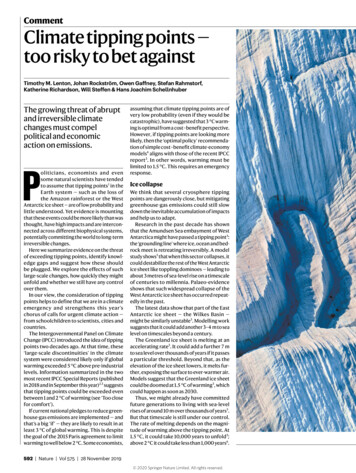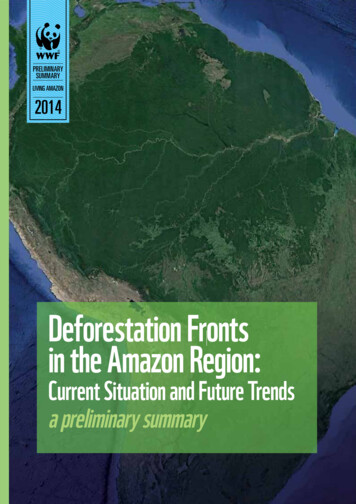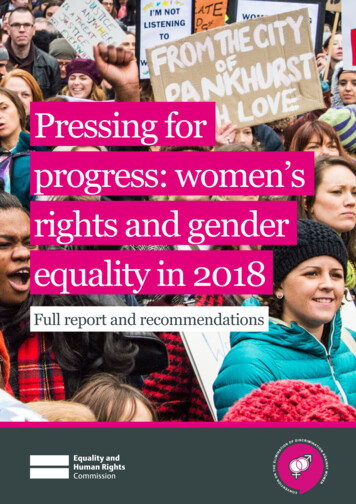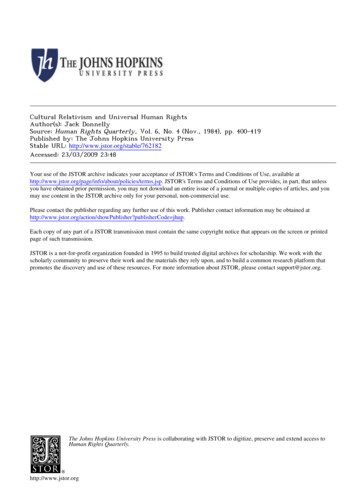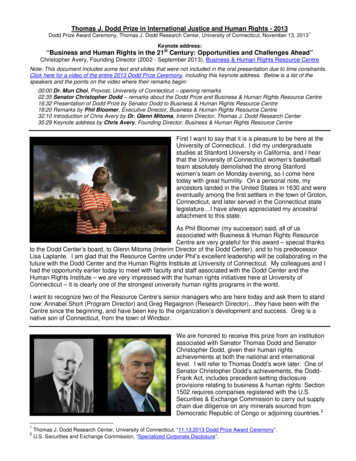
Transcription
Deforestation Driversand Human Rights in MalaysiaA national overview andtwo sub-regional case studiesCarol Yong, SACCESS and JKOASM
COUNTRY INFORMATION: MALAYSIAForest area:20,4566,000 hareported to FAO; other source reportreport cover to be significantly less at18,080,0000Forest peoples:8.5 million rural dwellers; 3.5 millionindigenous people,many still highly forestdependentForest land tenure:The state claims it owns and controls areasknown as ‘state land forests’. Ownership ofthese areas by local forest communities andindigenous peoples is largely unrecognised.Deforestation rate:0.54%: satellite images indicate annualaverage tree cover loss of as much as 2%.Main direct drivers of deforestation:Commercial logging; commercialagribusiness; mining; infrastructure; megadams and urban developmentsIndirect drivers of deforestationNational and state legal and policyinstruments with related contradictions,governance issues, trans-border forestcrimes, powerful political and economicelites, unethical financial and investmentculture, trade and consumption
MALAYSIAThis Malaysia case study is the revised and updated version of the draft report originally preparedas a contribution to the International Workshop on Deforestation Drivers and the Rights of ForestPeoples, held in Palangka Raya, Indonesia, March 9-14, 2014.Last updated September 2014About the author and contributors:Carol Yong is a Malaysian feminist activist with many years’ experience, having researched, writtenand published on a number of aspects of forest peoples, women and land relations, namely tenure,gender and development, human rights, development-induced displacement and resettlement,resource politics and corruption. She currently works as freelance consultant/researcher/writer.SACCESS (Sarawakians Access) is a Kuching-based, non-profit entity established in 1994 that offers“Information, Documentation and Research Consultancy Services” in support of human rights,including Native Customary Rights (NCR), democracy, justice and equality in Sarawak.JKOASM (Jaringan Kampung Orang Asli Semenanjung Malaysia) is the Peninsular Malaysia OrangAsli Village Network initiated by Tijah Yok Chopil, the network’s current coordinator. The fieldinformation on Kg. Sebir for this case study was collected by two Orang Asli community activistsand JKOASM members, Norsinani Binti Achin and Asmidar Vira Binti Les.(Image 1) The remaining fragments of healthy forest in Malaysia are mainly located on the lands andterritories of indigenous peoples, yet these lands lack effective protection and are vulnerable todestruction by logging, mining, plantation developments, etc.1
MALAYSIAACKNOWLEDGEMENTSThis Malaysia case study includes two sub-regional field reports contributed by SACCESS inKuching, Sarawak and JKOASM in Peninsular Malaysia. The Sarawak field study was undertakenby field researchers of SACCESS working closely with the Long Itam Penan community and landrights lawyer See Chee How. The Peninsular Malaysia field study was facilitated by JKOASM and inparticular by its coordinator Tijah Yok Chopil, and data collection and interviews in Kg. Sebir wereundertaken by two JKOASM members and community activists, Norsinani Binti Achin and AsmidarVira Binti Les. My immeasurable gratitude to the many women and men, young and old, from LongItam and Kg. Sebir for their time and willingness to participate in this initiative, along with See CheeHow and the NGO/IPO that assisted. We do our best to adequately reflect the peoples’ lives andexperiences, adat, oral history, practices, hopes and fears in this case study.The process of putting together this whole case study and the two local case studies presented herehas been challenging, to say the least, and the whole report should be read with due consideration ofa number of limitations. These included time constraints, changing scenarios on the ground and thediffering situations of the different regions within Malaysia and Malaysia as a whole, which resultedin further challenges, balancing the need to get the most current data and information and meetingthe timelines for this report. Specific interviews and communications with Sarawak’s land rightslawyer, activists, academics and others in Malaysia and abroad, helped to address information andanalysis gaps. Some limitations could be addressed with indirect and/or secondary sources usedwhere primary sources were not available. We hope the information, findings and recommendationscontained in this final manuscript will contribute to continuing debates, and lead to solutions forprotecting forests and securing rights of forests peoples.Special thanks go to Joji Cariño, FPP Director, and Tom Griffiths, Coordinator of FPP’s ResponsibleFinance Programme (RFP), for inviting us to undertake this Malaysian case study, and for their timeand energy in guiding us through all stages of the research. I especially appreciated the insightfulcomments and suggestions from Tom on various drafts of the manuscript. I wish to thank otherreviewers who helped with the manuscript, in particular Helen Tugendhat who was kind enough toread the full case study and made valuable corrections that improved the final manuscript. I also wishto thank Jane Butler for her time and energy in proof-reading and designing the study, and preparingthe pdf copy for the FPP’s website. Sincere gratitude to all those who gave their time to help in variousways: Julia Overton, Sarah Roberts, Sophie Chao, Beata Delcourt, Viola Belohrad, Fiona Cottrell,Kate Bridges, Sue Richards and James Harvey of FPP and Miles Litvinoff.This case study was originally prepared for the International Workshop on Deforestation Driversand the Rights of Forest Peoples held in March in Palangka Raya, Central Kalimantan, Indonesia, cohosted by FPP and Pusaka. The participation of the Malaysians in the Palangka Raya workshop wouldnot have been possible without the invitation and the facilitation of FPP, PUSAKA and POKKERSHK: sincere gratitude to all of you. The workshop provided a venue for the presentation of thedraft of the report. Feedback received from the workshop organisers and participants is gratefullyacknowledged, and related points have been incorporated into this report.For their immense help in tracking down publications and references and sharing their wisdom andinsightful comments, I owe a special debt of gratitude to See Chee How, Wee Aik Pang and Wong2
MALAYSIAMeng Chuo. My sincere gratitude to Saskia Ozinga (FERN), Lukas Straumann (BMF) and numerous otherNGO colleagues who were kind enough to read the manuscript draft and gave me thoughtful commentsand suggestions. The BMF, SACCESS, JKOASM and Save Malaysia, Stop Lynas! (SMSL) kindly offered theirhelp with photographs and BMF also helped with maps on Sarawak. Thanks are also given to respondentsof an email questionnaire about forests and deforestation issues in Malaysia and responses received wereincluded in this case study to present different views on these issues.SACCESS, JKOASM and Pusat KOMAS in Malaysia and FPP in the United Kingdom deserve specialmention for their help with administration and communications support between me and the communities.Special thanks to Wee Aik Pang, Saskia Ozinga, and the very few individuals in the background, forproviding me with reliable support, constructive criticisms, good humour, patience and encouragement atevery step of the way.Finally, financial support from FPP’s Rights, Forest and Climate Project for this case study and for fundingthe Malaysian participants in the Palangka Raya workshop is gratefully acknowledged.Carol Yong, November 2014.CONTENTSABBREVIATIONS, ACRONYMS AND TERMS 5EXECUTIVE SUMMARY 7National overview8Deforestation and forest degradation drivers 10General recommendations 15PART 1: OVERVIEW OF NATIONAL SITUATION19Historical deforestation 19Present deforestation 25PART 2: LOCAL ASSESSMENT 58Sub-regional case study 1: Long Itam, Middle Baram, Sarawak5874Sub-regional case study 2: Kg. Sebir, Labu, Negeri SembilanPART 3: SUMMARY AND RECOMMENDATIONS 87Direct causes 87Indirect or underlying drivers 87Effects of deforestation and forest degradation 88Lessons learned 90Community initiatives and solutions for securing rights and protecting forests923
MALAYSIAList of Maps, Figures/Table/Boxes and PlatesMapsMap 1-a: Forest cover in Sabah, Sarawak and Peninsular Malaysia, 2009Map 1-b: Google mapping of forest change (Global Forest Change, University of Maryland)Map 2: NCR of the Penan communities of Ba Abang, Long Itam and Long Kawi (Source: BMF)Map 3: Interhill concession area overlapping the NCR land of the Penan (Source: BMF)Figures/Table/BoxesFigure 1a: Population of Kg. Sebir by genderFigure 1b: Population of Kg. Sebir by broad age groupTable 1: Extent and Status of Forest Areas in Peninsular MalaysiaTable 2: Summary statistics on global/Malaysia tropical timber production, imports and exports,2008 (m3)Box 1: Definitional issues and questions over statisticsBox 2: Major causes of deforestation and forest degradation in MalaysiaBox 3: The ‘never-ending’ EU-Malaysia FLEGT VPA processBox 4: Sarawak’s Mega ‘Taib’ DamsList of platesFront cover, clockwise left to right: Penan hunting group, Sarawak; Kadazan woman with farm produce,Sabah; Temuan boy in community forest degraded by a dam project, Selangor; A Penan elder returningfrom his forest trip gathering forest produce in Long Ajeng, Ulu Baram, SarawakImage 1: Logging is a continuing threat to intact forestsImage 2: Indigenous children and their forestImage 3: Truck transporting felled logsImage 4: Piles of felled logs on the way out of Baram, SarawakImage 5: Forests are important as a source of clean waterImage 6: Community-NGO managed pre-school building in Long Itam villageImage 7: Quarry sites near Kg. Sebir villageImages 8/9: Indigenous womenImages 10/11: Children whose land and forest rights are threatenedImage 12: The forests through the eyes of a childPhotosFront cover images: SACCESS, Carol Yong, Carol Yong, SACCESS (clockwise left to right)Image 1: Carol YongImage 2: Carol YongImage 3: Carol YongImage 4: SACCESSImage 5: SACCESSImage 6: SACCESSImage 7: Norsinani Achin/Asmidar ViraImage 8: SACCESSImage 9: Carol YongImage 10: Carol YongImage 11: Carol YongImage 12: Drawing by Hashim4
MALAYSIAABBREVIATIONS, ACRONYMS AND TERMSAdatCustomary law systemsBMFBruno Manser Fund, a Swiss-based NGO focussing on Sarawak. Website: www.bmf.chCEDAWThe United Nations Convention on the Elimination of All Forms of DiscriminationAgainst WomenresinsDamarDIDDrainage and Irrigation Department (Malaysia)EIAEnvironmental Impact AssessmentEUEuropean UnionFAOFood and Agriculture Organization of the United NationsFELDAFederal Land Development Authority, previously a government agency but nowis corporatisedFERNA European NGO that promotes the conservation and sustainable use of forests,and respect for the rights of forest peoples in the policies and practices of theEuropean Union. Website: www.fern.orgFLEGT-VPA Forest Law Enforcement, Governance and Trade - Voluntary Partnership AgreementFMUForest Management UnitFPICFree, prior and informed consentFPOeFreiheitliche Partei Oesterreichs-The Austrian Freedom Party of Austria, far-rightparty.FPPForests Peoples Programme, an international human rights organisation based inthe UK. Website: www.forestpeoples.orgGaharuAguillar sp. Diseased wood from the inner core of the trunk, used as ingredient insome perfumesGFIGlobal Financial Integrity, a Washington-based financial watchdog.GOGovernmental organisationha hectaresHSBCHong Kong and Shanghai BankIJMMerger of three local construction companies: IGB Construction SB, Jurutama SBand Mudajaya SBIPOIndigenous Peoples OrganisationITTOInternational Tropical Timber OrganizationIUCNInternational Union for Conservation of NatureJAKOAJabatan Kemajuan Orang Asli/JAKOA (Department of Orang Asli Development),formerly Jabatan Hal Ehwal Orang Asli/JHEOA (Department of Orang Asli Affairs)Jaringan Kampung Orang Asli Semenanjung Malaysia (Network of Orang AsliJKOASMVillages Peninsular Malaysia)JOANGOJaringan Orang Asal & NGOs Tentang Hutan (indigenous peoples & NGOsHutancoalition on forest issues)Jaringan Orang Asal Se-Malaysia (The Indigenous Peoples Network of Malaysia)JOASlatex of kapor trees used by the PenanKaponKg./Kpg.Kampung (village)LCDALand Consolidation Development Authority (Sarawak land agency)5
MALAYSIALoggingOffA joint initiative by NGOs from European and timber-producing countriesinvolved in or monitoring the implementation of the EU FLEGT Action Plan,and specifically the VPA. Website: www.loggingoff.infoLembaga AdatOrang Asli traditional institution such as village council of eldersMACCMalaysian Anti-Corruption CommissionMolongPenan practice of using resources in a sustainable way to meet specific needswhile preserving or recovering trees, sago clumps, etc. for future harvestsMTCMalaysian Timber CouncilMTCC/MTCSMalaysian Timber Certification Council / Malaysian Timber CertificationSchemeNCRNative Customary RightsNGONon-governmental OrganisationNyatengPenan term for resin to get fireOeVPOesterreichische Volkspartei-Austrian People’s Party, centre-right partyPelimakOrang Asli Temuan term for community-appointed forest guardian/wardenPEFCPan European Certification SchemeRAGMRaub Australian Gold Mining Sdn BhdRECOFTCRegional Community Forestry Training CenterRSPORoundtable on Sustainable Palm OilSACCESSSarawakians Access, a Kuching-based non profit entitySCORESarawak Corridor of Renewable EnergySMSLSave Malaysia, Stop Lynas! SMSL is a citizens group set up solely to providespace for residents and concerned people because of the threats from anAustralian company. Lynas REE (rare earth elements) refining plant LAMPnear Kuantan, Malaysia. Website: www.savemalaysia.orgSPOeSozialdemokratische Partei Oesterreichs-The Austrian Socialist PartySUHAKAMSuruhanjaya Hak Asasi Manusia Malaysia/National Human RightsCommission of MalaysiaTanah PenguripNative customary rights (NCR) land and territorial domain of the Penans ofSarawakTanah PinggirFringe forest areas of the Orang Asli of Peninsular MalaysiaTKTuai Kampung, Village headUN United NationsUNDRIPUnited Nations Declaration on the Rights of Indigenous PeoplesUNEPUnited Nations Environment ProgrammeUvutSago starch from the palm Eugeissona utilis, Penan staple food and primarycarbohydrate source6
MALAYSIAEXECUTIVE SUMMARYDeforestation and forest degradation in Malaysia is a complex phenomenon with varying causes. So far,however, the focus is largely on direct or proximate causes like industrial logging, large-scale commercialoil palm plantations and agribusiness, road construction and large dams. Far less attention is paid tothe indirect or underlying causes and agents, inter-linking and working to enrich the very few whilecreating hardships for many people as a result of degraded or diminished resources. Major agents ofdeforestation include commercial loggers, commercial oil palm and other tree planters, infrastructuredevelopers or governmental and developmental agencies. As community forests are plundered andforests are cleared, local sustainable customary land use systems are confined to reduced areas of forestland threatening their sustainability. This has had harmful impacts on communities’ access to forestresources for livelihoods and food security, consequently intensifying livelihood hardship and poverty.Beyond the immediate losses, there is also the loss of generational stories, customs, tales, legends,history, and so on, that shape and define so much of the once forest dwellers.This report is one of several commissioned case studies of the FPP’s Rights, Forests and Climate Projectentitled: “Drivers of deforestation and human rights”. This FPP Project is an attempt to fill this gap inexamining the combinations of direct and underlying agents and causes of deforestation and forestdegradation in Malaysia, and to support the convening of a global workshop to analyse these problemsand develop solutions to the crisis.1This Malaysian case study was undertaken by a Malaysian consultant and a small team of local andcommunity researchers, following FPP’s terms of reference. It has been based on four main sources ofinformation: Review of existing literature and documents Fieldwork in two sub-regions in Malaysia Personal and professional experiences and understanding of a range of themes and issues Interviews, discussions and email communications with relevant individuals and groups inMalaysia and outsideThis case study report has three parts: Part 1 gives an overview of the status of Malaysia’s forests today, highlighting the major direct andunderlying causes of forest degradation and deforestation in the past and the present. Major globaldrivers of deforestation and forest destruction which interact with a number of local factors arediscussed. Where relevant, the roles of national and international efforts to tackle deforestationand rights abuses in Malaysia are mentioned.1 In the late 1990s, FPP has been actively involved in a 16-month initiative of a diverse group of NGOs, governments, indigenouspeoples’ organisations, intergovernmental agencies and other stakeholders that included 7 regional workshops, one IndigenousPeoples workshop, and a Global Workshop to Address the Underlying Causes of Deforestation and Forest Degradation. Case studiesand discussion papers to address a wide-range of forest-related issues formed the basis for discussions in these workshops. However,there was no specific case study on Malaysia. For an overall report on these theme and case studies, see, Verolme, Hans J.H., Moussa,Juliette, April 1999. Addressing the Underlying Causes of Deforestation and Forest Degradation - Case Studies, Analysis and PolicyRecommendations. Biodiversity Action Network, Washington, DC, USA. x 141pp. Available from: bionet@igc.org, http://www.wrm.org.uy/oldsite/deforestation/uc-rpt eng.pdf7
MALAYSIA Part 2 explores what is happening on-the-ground through fieldwork in two different geographicallocations: a Penan community in Middle Baram in Sarawak and an Orang Asli community inLabu, Negeri Sembilan in Peninsular Malaysia. The Penan of Long Itam in Middle Baram arestill struggling against logging, and have been since the 1980s when they and other native groupsfirst mounted blockades in logging roads.2 Most other Sarawak communities today are strugglingwith post-logging “development” including large-scale oil palm plantations, large dams and otherinfrastructure projects. For the Orang Asli, their forests and customary lands are also issued withconcessions and licences for “development”. While each case is unique, there are similar problemsfaced by the Penan and Orang Asli communities: their ancestral lands and forests have continuouslybeen encroached by direct and underlying agents of deforestation often without communities’Free, Prior and Informed Consent (FPIC) resulting in FPIC violations, loss of forests, land rightsand rights abuse. Other deforestation drivers like plantations development, large dams, roadconstruction that affect indigenous and local forest peoples are also discussed. Part 3 presents some main lessons learned as well as community initiatives and solutionsto protecting their forests and, more generally, some recommendations for a range of intergovernmental, governmental and non-governmental organisations in Malaysia and internationallyon addressing forest degradation and forest loss.Core findings of the Malaysian case study and analysis are outlined below.National OverviewThe last few decades have witnessed once-rich rainforests in Malaysia rapidly destroyed ordisproportionately damaged. NASA’s satellite-based tool to detect areas where deforestationand forest degradation is occurring on a quarterly basis, the Quarterly Indicator of CoverChange (QUICC), has ranked Malaysia second (150% increase) after Bolivia (162%) in termsof a surge in deforestation during the first quarter of 2014.3 These areas of significant new forestdisturbance are corroborated by FORMA alert data generated by Global Forest Watch, a forestmonitoring platform which also uses NASA data to generate reports on potential forest loss. Anew Google Earth mapping tool has likewise exposed alarming rates of deforestation and forestdegradation in Malaysia (Hansen et.al. 2013). The mapping team from University of Marylandthat documented forest loss and gain between 2000 and 2012 using satellite images, revealed that: Malaysia is one of three countries in the world with the highest national rates of deforestation(the other two countries being Cambodia and Paraguay). Malaysia lost 14.4% of its forests from 2000-2012, the world’s highest rate. Malaysia is ranked ninth in the world in highest area of forest loss. During 2000-2012, Malaysia lost a larger proportion of its dense forests (over 75% canopy) thanany other major tropical forest nation, an estimated 4.5 million ha of forests - equivalent to afootball pitch every 1.5 minutes.2 See, The Peaceful People: The Penan and their Fight for the Forest by Paul Malone, SIRD (2014), Pb 285 pp, ISBN: 9789670630366.Available from: http://gbgerakbudaya.com/bookshop/index.php?main page product book info&cPath 1 4&products id 23213 NASA detects surge in deforestation in Malaysia, Bolivia during first quarter of 2014, mongabay.com, April 21, 2014. Available in fullfrom: html#lUvBCJyvH4VHMr02.998
MALAYSIA Between 2010-2012 alone, Malaysia has lost 4.72 million ha of forests. Deforestation during the last decade is actually worse in Malaysia, in percentage terms, than inIndonesia. Actual deforestation rates in Malaysia since 2000 have been three times higher than Malaysiareports to the FAO.Another study further attested to the alarming trends in Malaysia’s forest loss. The research teamfrom the University of Tasmania, University of Papua New Guinea, and the Carnegie Institutionfor Science, using high-resolution satellite imaging of the Carnegie Landsat Analysis Systemlite (CLASlite), highlighted that more than 80% of tropical forests in Malaysian Borneo have beenheavily impacted by logging (Bryan et al, 2013). Analysis of satellite imagery collected from 1990and 2009 over Malaysian Borneo showed approximately 226,000 miles (364,000 km) of roadsconstructed throughout the forests of this region. Nearly 80% of the land surface of Sabah andSarawak was impacted by previously undocumented, high-impact logging or clearing operations.The research further revealed that only 3% of land area in Sarawak remains covered by intact forests indesignated protected areas. These findings strongly contrasted with neighbouring Brunei, where 54%of the land area is intact unlogged forest. The study’s team leader, Jane Bryan, was reported as saying:“There is a crisis in tropical forest ecosystems worldwide, and our work documents the extent of thecrisis on Malaysian Borneo. Only small areas of intact forest remain in Malaysian Borneo, because somuch has been heavily logged or cleared for timber or oil palm production.” We add that those areasnot already cleared are under immediate threat as logging concessions are active and loggers are everadvancing into intact forests on a daily basis.A series of field investigations by FPP with local partners and communities in Malaysia also revealedalarming findings and projections of degradation of forests and subsequent conversion/clearance forpalm oil expansion, particularly in Sabah and Sarawak (FPP, Sawit Watch and TUK Indonesia, 2013).With most of the economically-attractive forest for timber extraction now gone, the timber industryis shrinking and has been overtaken or replaced by large-scale oil palm plantation development andindustrial tree-plantations. For example, Sarawak currently has one million ha of land under oil palmand the Sarawak state government intends to double that huge area to 2 million ha by 2015, and possiblyeven up to 3 million ha (Sarawak Report, 20 January 2014). As for industrial tree plantations, theSarawak government has set a target of 1 million ha by 2020 but with licences issued for 2.8 million ha.4Are these trends likely to continue in the future? All indications point to a continuing increase inlogging as concessions have not been halted but instead renewed, and logging continues on a dailybasis. Analyses of inter-linking causes and actors, discussed later, also point to much work that needsto be done to keep the remaining forested areas in Malaysia intact. The loss of forest cover today is thecontinuation of a process that began during colonial rule that saw the exploitation of natural wealthof the colonies for the enrichment of the motherland England. In Malaysia, the evidence is clear inthe lasting influence of colonial era policies and laws on land and forests. However, the process ofdeforestation is far greater today than it ever was during the colonial era, and much of the exploitationof natural wealth today is embedded in allegations of massive corruption. The indigenous landowners’efforts to save their forests and lands are effectively the last safeguard against total loss of intact forests.4 Source: http://sarawaktimber.org.my/timber -tree-plantations.html9
MALAYSIADeforestation and Forest Degradation DriversDirect causes Industrial logging, both legal and illegal, causing degradation of forest resources. Indirect consequences of logging, such as the construction of forest roads to access the camps andtemporary housing for logging workers, river pollution and damage to the forest floor, soil, vegetation, etc.by logging trucks and heavy machinery. These forest roads often open forests to further encroachmentnot only by the logging companies but also migrants to clear remaining trees, etc. Natural forest clearance or conversion of forested lands to other land uses, usually with loggingas a precursor. These other activities include: oil palm and other industrial tree plantations,agribusiness expansion, large dams, extractive industries such as mining and quarrying (e.g. openpit, blasting) and mining-related activities such as the processing facilities and the tailings, andland development and other land schemes (e.g. agricultural schemes, rubber estates, and so on). Infrastructure and urban development projects such as construction of roads and highways,industrial plants and factories, hilltop bungalows and resorts, and other facilities related tourbanisation and demographic changes. Consumer demands for logs and for palm oil, particularly among food producers and the biodiesel industry, have resulted in more forests being logged and or cleared to establish new palmplantations, leading also to increasing commodification of nature and natural resources.Indirect or underlying driversBehind the direct causes are multiple indirect processes and drivers, which are usually interconnectedand vary regionally within the country. The important underlying causes include: National and state legal and policy instruments and related contradictions arising from differentlevels and actors of federal and state power and jurisdictions over land and forestry legislationand policies. Protection of each state’s power over land and forest resources often results incontinued contradictions with federal government’s policies, regulations, enforcement, projects,etc. However, the development choices of both federal and state governments have favoured largescale projects such as commercial agriculture plantations, large dam projects, etc. Monitoring andenforcement of the many laws for land and forest protection is relatively weak, and inevitablythe government role in tackling the many issues connected with deforestation is also weakened. Many of the existing land and forest laws have colonial (British) origins. These laws and policiesare not only outdated but have over time been amended and tightened by post-independentfederal and state governments steadily eroding the collective customary rights of forest peoplesover their lands. Pre-existing customary land rights of forest peoples are systematically ignoredand overridden, which contributed considerably to unjust land acquisition and concessionallocations to commercial enterprises, at the same time failing to uphold the core standard of FPIC. Weak or flawed forest governance, absent of provisions for full local forest community and genderedperspectives. As a result, forest governance exacerbates the disempowerment of local communitiesand marginalisation of women, women’s rights to community resources, and unequal and insecureland tenure of families and forest communities.10
MALAYSIA Ineffective governance or incorrect governance system: a non-transparent, non-accountablesystem of governance that allows for corrupt politicians to lease out licences for loggingand then for land leases to be issued to corporations and private individuals at the expenseof land owners. Yet, Malaysia’s “commitment” to curb systemic corruption, nepotism andpolitical patronage in appropriation of forests and natural resources through logging,land leases and concessions, especially of politically exposed persons, remains to be seen. Interaction of international, national and local factors, including links with trans-border forestgovernance and crimes, e.g. global corruption, money laundering, tax evasion.5 Malaysia ranksfourth in global capital flight (GFI report, 2013). Logging concessions, permits, contractsand allocation of rights to exploit forests and state assets are often controlled or held bypowerful political and economic elites and well-connected corporations. Also, unethicalfinancial and investment culture, u
GFI Global Financial Integrity, a Washington-based financial watchdog . (The Indigenous Peoples Network of Malaysia) Kapon latex of kapor trees used . land agency) MALAYSIA 6 LoggingOff A joint initiative by NGOs from European and timber-producing countries involved in or monitoring the implementation of the EU FLEGT Action Plan, and .





